A Death in the Family Royal Wedding Art Painting
| The Arnolfini Portrait | |
|---|---|
 | |
| Artist | Jan van Eyck |
| Year | 1434 |
| Type | Oil on oak panel of iii vertical boards |
| Dimensions | 82.2 cm × 60 cm (32.four in × 23.vi in); console 84.five cm × 62.5 cm (33.iii in × 24.6 in) |
| Location | National Gallery, London |
The Arnolfini Portrait (or The Arnolfini Wedding , The Arnolfini Marriage , the Portrait of Giovanni Arnolfini and his Wife , or other titles) is a 1434 oil painting on oak console by the Early Netherlandish painter Jan van Eyck. It forms a full-length double portrait, believed to depict the Italian merchant Giovanni di Nicolao Arnolfini and his wife, presumably in their residence at the Flemish urban center of Bruges.
It is considered one of the most original and complex paintings in Western art, considering of its beauty, complex iconography,[1] geometric orthogonal perspective,[2] and expansion of the picture space with the use of a mirror.[3] [four] Co-ordinate to Ernst Gombrich "in its own style it was every bit new and revolutionary as Donatello's or Masaccio's work in Italy. A simple corner of the existent world had suddenly been fixed on to a panel as if by magic... For the beginning time in history the artist became the perfect eye-witness in the truest sense of the term".[five] The portrait has been considered by Erwin Panofsky and some other art historians equally a unique grade of marriage contract, recorded as a painting.[six] Signed and dated by van Eyck in 1434, it is, with the Ghent Altarpiece by the aforementioned artist and his brother Hubert, the oldest very famous panel painting to have been executed in oils rather than in tempera. The painting was bought by the National Gallery in London in 1842.
Van Eyck used the technique of applying several layers of thin translucent glazes to create a painting with an intensity of both tone and colour. The glowing colours also help to highlight the realism, and to show the material wealth and opulence of Arnolfini's globe. Van Eyck took advantage of the longer drying fourth dimension of oil pigment, compared to tempera, to alloy colours by painting wet-in-wet to reach subtle variations in light and shade to heighten the illusion of three-dimensional forms. The wet-in-wet (moisture-on-wet), technique, also known as alla prima, was highly utilized by Renaissance painters including January van Eyck.[vii] The medium of oil paint also permitted van Eyck to capture surface appearance and distinguish textures precisely. He also rendered the effects of both direct and lengthened light past showing the light from the window on the left reflected by diverse surfaces. It has been suggested that he used a magnifying drinking glass in order to pigment the minute details such equally the individual highlights on each of the amber beads hanging beside the mirror.
The illusionism of the painting was remarkable for its time, in part for the rendering of detail, merely particularly for the use of light to evoke infinite in an interior, for "its utterly convincing delineation of a room, likewise of the people who inhabit it".[8] Whatever significant is given to the scene and its details, and at that place has been much debate on this, according to Craig Harbison the painting "is the only fifteenth-century Northern panel to survive in which the artist'south contemporaries are shown engaged in some sort of action in a gimmicky interior. Information technology is indeed tempting to call this the commencement genre painting – a painting of everyday life – of modern times".
Clarification [edit]
In the typical Dutch way, this painting contains an incredible mastery of form, brushwork and colour to create intense details.
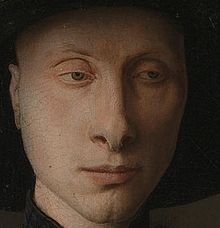
The painting is generally in very good status, though with pocket-size losses of original pigment and damages, which have mostly been retouched. Infrared reflectograms of the painting testify many small-scale alterations, or pentimenti, in the underdrawing: to both faces, to the mirror, and to other elements.[nine] The couple are shown in an upstairs room with a chest and a bed in information technology during early summer as indicated past the fruit on the cherry tree outside the window. The room probably functioned as a reception room, as it was the manner in French republic and Burgundy where beds in reception rooms were used as seating, except, for example, when a mother with a new babe received visitors. The window has six interior wooden shutters, only only the elevation opening has drinking glass, with clear bulls-eye pieces set in blue, ruby and dark-green stained glass.[9]
The two figures are very richly dressed; despite the season both their outer garments, his tabard and her dress, are trimmed and fully lined with fur. The furs may be the especially expensive sable for him and ermine or miniver for her. He wears a chapeau of plaited straw dyed blackness, every bit oftentimes worn in the summer at the time. His tabard was more majestic than it appears now (as the pigments take faded over time) and may be intended to exist silk velvet (some other very expensive item). Underneath he wears a doublet of patterned material, probably silk damask. Her dress has elaborate dagging (cloth folded and sewn together, then cut and frayed decoratively) on the sleeves, and a long railroad train. Her blue underdress is also trimmed with white fur.[9]
Although the adult female's evidently gold necklace and the rings that both wearable are the but jewellery visible, both outfits would have been enormously expensive, and appreciated as such by a contemporary viewer. In that location may be an element of restraint in their clothes (especially the homo) befitting their merchant status – portraits of aristocrats tend to show gold chains and more decorated fabric,[nine] although "the restrained colours of the human being's vesture represent to those favoured by Knuckles Phillip of Burgundy".[x]
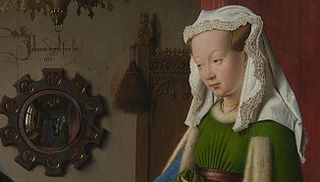
Particular showing the female subject area and convex mirror
The interior of the room has other signs of wealth; the contumely chandelier is big and elaborate by contemporary standards, and would have been very expensive. It would probably have had a machinery with pulley and chains above, to lower information technology for managing the candles (perchance omitted from the painting for lack of room). The convex mirror at the back, in a wooden frame with scenes of The Passion painted behind glass, is shown larger than such mirrors could actually be made at this date – another unimposing departure from realism by van Eyck. There is also no sign of a fireplace (including in the mirror), nor anywhere obvious to put 1. Fifty-fifty the oranges casually placed to the left are a sign of wealth; they were very expensive in Burgundy, and may have been i of the items dealt in by Arnolfini. Further signs of luxury are the elaborate bed-hangings and the carvings on the chair and bench against the back wall (to the right, partly hidden by the bed), too the pocket-size Oriental carpet on the floor by the bed; many owners of such expensive objects placed them on tables, as they yet do in holland.[9] [ten] There existed a friendship between Giovanni Arnolfini and Philip the Good who sent his court painter Jan van Eyck to portray Arnolfini Double. The relation possibly began with a tapestry society including the images of Notre Dame Cathedral in render of a good payment.[7]
The view in the mirror shows two figures just inside the door that the couple are facing. The second effigy, wearing red, is presumably the artist although, different Velázquez in Las Meninas, he does not seem to exist painting. Scholars accept made this assumption based on the appearance of figures wearing red caput-dresses in some other van Eyck works (e.g., the Portrait of a Human being (Cocky Portrait?) and the effigy in the groundwork of the Madonna with Chancellor Rolin). The dog is an early grade of the breed at present known as the Brussels griffon.[9]
The painting is signed, inscribed and dated on the wall above the mirror: "Johannes de eyck fuit hic 1434" ("Jan van Eyck was here 1434"). The inscription looks as if it were painted in large letters on the wall, every bit was washed with proverbs and other phrases at this catamenia. Other surviving van Eyck signatures are painted in trompe-l'œil on the wooden frame of his paintings, so that they appear to have been carved in the wood.[nine] [11]
Identity of subjects [edit]

In their book published in 1857, Crowe and Cavalcaselle were the commencement to link the double portrait with the early 16th century inventories of Margaret of Austria. They suggested that the painting showed portraits of Giovanni [di Arrigo] Arnolfini and his wife.[12] Iv years afterwards James Weale published a volume in which he agreed with this assay and identified Giovanni's wife as Jeanne (or Giovanna) Cenami.[13] For the side by side century most art historians accepted that the painting was a double portrait of Giovanni di Arrigo Arnolfini and his wife Jeanne Cenami only a chance discovery published in 1997 established that they were married in 1447, thirteen years after the date on the painting and vi years later on van Eyck's death.[14]
It is now believed that the subject is either Giovanni di Arrigo or his cousin, Giovanni di Nicolao Arnolfini, and a wife of either 1 of them. This is either an undocumented get-go married woman of Giovanni di Arrigo or a 2nd wife of Giovanni di Nicolao, or, co-ordinate to a recent proposal, Giovanni di Nicolao'south showtime wife Costanza Trenta, who had died perhaps in childbirth past February 1433.[xv] In the latter case, this would brand the painting partly an unusual memorial portrait, showing one living and one dead person. Details such as the snuffed candle above the woman, the scenes after Christ's expiry on her side of the background roundel, and the blackness garb of the homo, support this view.[fifteen] Both Giovanni di Arrigo and Giovanni di Nicolao Arnolfini were Italian merchants, originally from Lucca, just resident in Bruges since at least 1419.[xi] The human in this painting is the subject of a further portrait by van Eyck in the Gemäldegalerie, Berlin, leading to speculation he was a friend of the artist.[16]
Scholarly debate [edit]
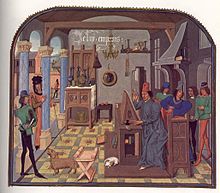
Charles the Bold surprising David Aubert, a miniature with an unusual variant of the presentation portrait, probably alluding to Alexander the Great, who surprised one of his artists in similar fashion. The rear wall seems to refer to the Arnolfini Portrait of xl years earlier, containing many of the same objects like the convex mirror and in particular the painted inscription on the wall. Loyset Liédet, before 1472.
In 1934 Erwin Panofsky published an commodity entitled January van Eyck's 'Arnolfini' Portrait in the Burlington Mag, arguing that the elaborate signature on the back wall, and other factors, showed that information technology was painted as a legal tape of the occasion of the union of the couple, consummate with witnesses and a witness signature.[17] Panofsky also argues that the many details of domestic items in the painting each have a disguised symbolism attached to their appearance. While Panofsky's merits that the painting formed a kind of certificate of wedlock is non accepted by all fine art historians, his analysis of the symbolic function of the details is broadly agreed, and has been applied to many other Early Netherlandish paintings, specially a number of depictions of the Declaration gear up in richly detailed interiors, a tradition for which the Arnolfini Portrait and the Mérode Altarpiece past Robert Campin represent the start (in terms of surviving works at least).[eighteen]
Since then, in that location has been considerable scholarly argument amongst art historians on the occasion represented. Edwin Hall considers that the painting depicts a betrothal, not a marriage. Margaret D. Carroll argues that the painting is a portrait of a married couple that alludes also to the hubby's grant of legal say-so to his wife.[19] Carroll also proposes that the portrait was meant to affirm Giovanni Arnolfini'south practiced graphic symbol as a merchant and aspiring member of the Burgundian court. She argues that the painting depicts a couple, already married, now formalizing a subsequent legal arrangement, a mandate, past which the hubby "easily over" to his wife the legal authority to acquit business organisation on her own or his behalf (like to a ability of chaser). The claim is non that the painting had any legal force, simply that van Eyck played upon the imagery of legal contract as a pictorial conceit. While the ii figures in the mirror could exist thought of as witnesses to the oath-taking, the artist himself provides (witty) authentication with his notarial signature on the wall.[twenty]

Johannes de eyck fuit hic 1434 (January van Eyck was hither. 1434).
January Baptist Bedaux agrees somewhat with Panofsky that this is a marriage contract portrait in his 1986 commodity "The reality of symbols: the question of disguised symbolism in January van Eyck'southward Arnolfini Portrait." However, he disagrees with Panofsky's idea of items in the portrait having subconscious meanings. Bedaux argues, "if the symbols are disguised to such an extent that they do not clash with reality as conceived at the time ... there volition be no means of proving that the painter actually intended such symbolism."[21] He also conjectures that if these disguised symbols were normal parts of the wedlock ritual, then ane could not say for sure whether the items were part of a "disguised symbolism" or just social reality.[21]
Craig Harbison takes the middle footing betwixt Panofsky and Bedaux in their argue about "bearded symbolism" and realism. Harbison argues that "January van Eyck is in that location as storyteller ... [who] must have been able to understand that, inside the context of people's lives, objects could have multiple associations", and that there are many possible purposes for the portrait and means it can be interpreted.[22] He maintains that this portrait cannot be fully interpreted until scholars take the notion that objects can have multiple associations. Harbison urges the notion that ane needs to deport a multivalent reading of the painting that includes references to the secular and sexual context of the Burgundian courtroom, too as religious and sacramental references to marriage.
Lorne Campbell in the National Gallery Catalogue sees no need to find a special meaning in the painting: "... there seems trivial reason to believe that the portrait has any significant narrative content. Only the unnecessary lighted candle and the strange signature provoke speculation."[23] He suggests that the double portrait was very possibly made to commemorate a union, merely not a legal record and cites examples of miniatures from manuscripts showing similarly elaborate inscriptions on walls equally a normal grade of decoration at the time. Another portrait in the National Gallery past van Eyck, Portrait of a Man (Leal Gift), has a legalistic form of signature.[11]
Margaret Koster's new proposition, discussed higher up and below, that the portrait is a memorial i, of a married woman already dead for a yr or so, would displace these theories. Fine art historian Maximiliaan Martens has suggested that the painting was meant as a gift for the Arnolfini family in Italy. It had the purpose of showing the prosperity and wealth of the couple depicted. He feels this might explain oddities in the painting, for example why the couple are standing in typical winter clothing while a cherry tree is in fruit outside, and why the phrase "Johannes de eyck fuit hic 1434" is featured and so large in the centre of the painting. Herman Colenbrander has proposed that the painting may depict an old High german custom of a husband promising a souvenir to his bride on the morn after their wedding nighttime. He has also suggested that the painting may accept been a present from the creative person to his friend.[24]
In 2016, French doc Jean-Philippe Postel, in his volume Fifty'Affaire Arnolfini, agreed with Koster that the woman is dead, just he suggested that she is appearing to the human being as a spectre, asking him to pray for her soul.[25]
Estimation and symbolism [edit]
Figures and marriage [edit]
It is thought that the couple are already married considering of the adult female's headdress. A not-married woman would have her pilus down, co-ordinate to Margaret Carroll.[26] The placement of the two figures suggests conventional 15th century views of marriage and gender roles – the woman stands near the bed and well into the room, symbolic of her role as the caretaker of the house and solidifying her in a domestic office, whereas Giovanni stands near the open window, symbolic of his role in the outside world. Arnolfini looks directly out at the viewer; his married woman gazes obediently at her husband. His hand is vertically raised, representing his commanding position of authority, whilst she has her hand in a lower, horizontal, more submissive pose. However, her gaze at her husband tin can too show her equality to him considering she is not looking down at the flooring as lower-form women would. They are office of the Burgundian court life and in that system she is his equal, non his lowly subordinate.[27]
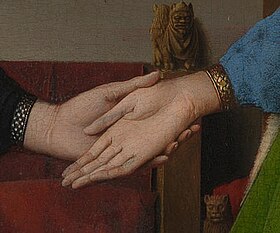
Detail showing the couple's joined hands.
The symbolism behind the action of the couple's joined hands has too been debated amidst scholars. Many point to this gesture as proof of the painting'south purpose. Is it a marriage contract or something else? Panofsky interprets the gesture as an act of fides, Latin for "marital oath". He calls the representation of the couple "qui desponsari videbantur per fidem" which means, "who were contracting their marriage by marital adjuration".[28] The man is grasping the woman'due south correct hand with his left, which is the footing for the controversy. Some scholars like Jan Baptist Bedaux and Peter Schabacker argue that if this painting does show a wedlock ceremony, and so the use of the left hand points to the union existence morganatic and not hush-hush. A matrimony is said to exist morganatic if a man marries a woman of unequal rank.[29] However, the subjects originally thought past most scholars to exist represented in this painting, Giovanni Arnolfini and Giovanna Cenami, were of equal status and rank in the courtly organisation, so the theory would not hold true.[29] On the reverse side of the contend are scholars similar Margaret Carroll. She suggests that the painting deploys the imagery of a contract between an already married couple giving the married woman the authority to human activity on her husband's behalf in business dealings.[xxx] Carroll identifies Arnolfini'southward raised right hand as a gesture of oath-taking known every bit "fidem levare", and his joining easily with his married woman every bit a gesture of consent known as "fides manualis".[31]
Although many viewers assume the married woman to be meaning, this is not believed to exist then. Art historians point to numerous paintings of female virgin saints similarly dressed, and believe that this look was fashionable for women's dresses at the time.[32] Fashion would have been of import to Arnolfini, especially since he was a fabric merchant. The more than cloth a person wore, the more wealthy he or she was causeless to be. Another indication that the adult female is not pregnant is that Giovanna Cenami (the identification of the woman according to most earlier scholars) died childless,[33] as did Costanza Trenta (a possible identification according to recent archival bear witness);[15] whether a hypothetical unsuccessful pregnancy would have been left recorded in a portrait is questionable, although if information technology is indeed Constanza Trenta, equally Koster proposed, and she died in childbirth, so the oblique reference to pregnancy gains strength. Moreover, the beauty platonic embodied in gimmicky female person portraits and clothing residual in the first place on the high valuation on the ability of women to bear children. Harbison maintains her gesture is merely an indication of the extreme desire of the couple shown for fertility and progeny.[34]
There is a carved effigy as a finial on the bedpost, probably of Saint Margaret, patron saint of pregnancy and childbirth,[35] who was invoked to assist women in labor and to cure infertility, or maybe representing Saint Martha, the patroness of housewives.[36] From the bedpost hangs a brush, symbolic of domestic duties. Furthermore, the castor and the rock crystal prayer-beads (a popular engagement present from the future bridegroom) appearing together on either side of the mirror may besides allude to the dual Christian injunctions ora et labora (pray and work). Co-ordinate to Jan Baptist Bedaux, the broom could also symbolize proverbial chastity; it "sweeps out impurities".[37] [38]
Mirror [edit]
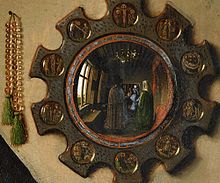
The small medallions fix into the frame of the convex mirror at the back of the room show tiny scenes from the Passion of Christ and may represent God'southward promise of salvation for the figures reflected on the mirror's convex surface. Furthering the Memorial theory, all the scenes on the wife's side are of Christ's death and resurrection. Those on the husband's side business Christ's life. The mirror itself may represent the eye of God observing the vows of the wedding. A spotless mirror was also an established symbol of Mary, referring to the Holy Virgin's immaculate conception and purity.[35] The mirror reflects ii figures in the doorway, i of whom may exist the painter himself. In Panofsky'due south controversial view, the figures are shown to bear witness that the 2 witnesses required to make a wedding legal were present, and Van Eyck's signature on the wall acts as some form of bodily documentation of an event at which he was himself present.
Co-ordinate to one author "The painting is oftentimes referenced for its immaculate depiction of non-Euclidean geometry",[39] referring to the image on the convex mirror. Bold a spherical mirror, the distortion has been correctly portrayed, except for the leftmost role of the window frame, the near edge of the table and the hem of the clothes.[forty]
Other objects [edit]

The little canis familiaris may symbolize fidelity (fido), loyalty,[35] or alternatively lust, signifying the couple's desire to have a kid.[41] Different the couple, he looks out to meet the gaze of the viewer.[42] The canis familiaris could exist simply a lap dog, a souvenir from husband to wife. Many wealthy women in the courtroom had lap dogs as companions, reflecting the wealth of the couple and their position in ladylike life.[43] The canis familiaris appears to be a Griffon terrier, or perhaps a Bolognese dog.[44]
The green of the woman's dress symbolizes hope, possibly the hope of condign a mother. Its intense effulgence too indicates wealth, since dyeing material such a shade was difficult and expensive.[45] Her white cap could signify purity or her status as married. Behind the pair, the defunction of the spousal relationship bed have been opened; the carmine curtains might allude to the concrete act of love.
The unmarried candle in the left-front holder of the ornate half-dozen-branched chandelier is possibly the candle used in traditional Flemish matrimony customs.[35] Lit in full daylight, similar the sanctuary lamp in a church, the candle may allude to the presence of the Holy Ghost or the ever-nowadays center of God. Alternatively, Margaret Koster posits that the painting is a memorial portrait, equally the single lit candle on Giovanni'southward side contrasts with the burnt-out candle whose wax stub can just be seen on his wife's side, in a visual play on a common metaphor: he lives on, she is dead.[46]
The cherries present on the tree outside the window may symbolize love. The oranges which lie on the window sill and breast may symbolize the purity and innocence that reigned in the Garden of Eden before the Fall of Human being.[35] They were uncommon and a sign of wealth in the Netherlands, simply in Italy were a symbol of fecundity in marriage.[47] More but, the fruit could be a sign of the couple's wealth, since oranges were very expensive imports.
In January 2018 the woman's dress was the field of study of the BBC Four programme A Stitch in Time with fashion historian Amber Butchart.[48]
Provenance [edit]
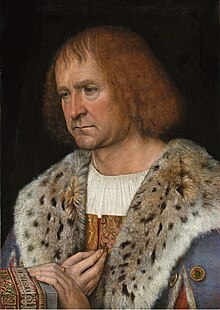
The provenance of the painting begins in 1434 when it was dated past van Eyck and presumably owned by the sitter(due south). At some point before 1516 it came into the possession of Don Diego de Guevara (d. Brussels 1520), a Spanish career courtier of the Habsburgs (himself the subject of a fine portrait by Michael Sittow in the National Gallery of Art). He lived about of his life in holland, and may accept known the Arnolfinis in their later years.[49]
By 1516 he had given the portrait to Margaret of Austria, Habsburg Regent of holland, when it shows up equally the showtime item in an inventory of her paintings, made in her presence at Mechelen. The item says (in French): "a large picture which is called Hernoul le Fin with his wife in a bedchamber, which was given to Madame by Don Diego, whose artillery are on the cover of the said picture; washed past the painter Johannes." A note in the margin says "It is necessary to put on a lock to close information technology: which Madame has ordered to be done." In a 1523–4 Mechelen inventory, a like description is given, although this time the name of the subject area is given equally "Arnoult Fin".[49]
In 1530 the painting was inherited by Margaret'southward niece Mary of Hungary, who in 1556 went to live in Espana. It is clearly described in an inventory taken after her expiry in 1558, when it was inherited by Philip II of Spain. A painting of two of his young daughters, Infantas Isabella Clara Eugenia and Catalina Micaela of Spain (Prado), deputed past Philip clearly copies the pose of the figures. In 1599 a German language company saw it in the Alcazar Palace in Madrid. Now it had verses from Ovid painted on the frame: "See that y'all promise: what harm is there in promises? In promises anyone can be rich." Information technology is very likely that Velázquez knew the painting, which may have influenced his Las Meninas, which shows a room in the same palace.[49] In 1700 the painting appeared in an inventory after the death of Carlos 2 with shutters and the verses from Ovid.
The painting survived the fire in the Alcazar which destroyed some of the Castilian royal collection, and by 1794 had been moved to the "Palacio Nuevo", the present Royal Palace of Madrid. In 1816 the painting was in London, in the possession of Colonel James Hay, a Scottish soldier. He claimed that after he was seriously wounded at the Battle of Waterloo the previous twelvemonth, the painting hung in the room where he convalesced in Brussels. He cruel in beloved with it, and persuaded the owner to sell. More relevant to the real facts is no doubt Hay's presence at the Boxing of Vitoria (1813) in Spain, where a large charabanc loaded by King Joseph Bonaparte with easily portable artworks from the royal collections was first plundered past British troops, earlier what was left was recovered by their commanders and returned to the Spanish.
Hay offered the painting to the Prince Regent, later George IV of the Great britain, via Sir Thomas Lawrence. The Prince had it on approval for two years at Carlton House earlier eventually returning it in 1818. Effectually 1828, Hay gave it to a friend to look afterward, not seeing it or the friend for the side by side thirteen years, until he arranged for it to exist included in a public exhibition in 1841. It was bought the following year (1842) by the recently formed National Gallery, London for £600, as inventory number 186, where it remains. Past and then the shutters had gone, along with the original frame.[49]
Notes [edit]
- ^ Ward, John. "Disguised Symbolism as Enactive Symbolism in Van Eyck's Paintings". Artibus et Historiae, Vol. xv, No. 29 (1994), pp. 9–53
- ^ Elkins, John, "On the Arnolfini Portrait and the Lucca Madonna: Did January van Eyck Have a Perspectival System?". The Fine art Message, Vol. 73, No. 1 (March 1991), pp. 53–62
- ^ Ward, John 50. "On the Mathematics of the Perspective of the "Arnolfini Portrait" and like works of Jan van Eyck", Art Bulletin, Vol. 65, No. 4 (1983) p.680
- ^ Seidel, Linda. "Jan van Eyck's Arnolfini Portrait": Business as Usual?". Critical Research, Vol. 16, No. 1 (Autumn, 1989), pp. 54–86
- ^ Gombrich, E.H., The Story of Art, p. 180, Phaidon, 13th edn. 1982. ISBN 0-7148-1841-0
- ^ Harbison, Craig. "Sexuality and Social Standing in Arnolfini's Double Portrait". Renaissance Quarterly, Vol. 43, No. 2 (Summer, 1990), pp. 249–291
- ^ a b "The Arnolfini Portrait by Jan van Eyck". Articonog.
- ^ Dunkerton, Jill, et al., Giotto to Dürer: Early Renaissance Painting in the National Gallery, page 258. National Gallery Publications, 1991. ISBN 0-300-05070-iv
- ^ a b c d e f thousand Campbell 1998, 186–191 for all this section, except as otherwise indicated.
- ^ a b Harbison 1991, 37
- ^ a b c Campbell 1998, 174–211
- ^ Hall 1994, 4; Crowe and Cavalcaselle 1857, 65–66
- ^ Weale 1861, 27–28; Campbell 1998, 193
- ^ Campbell 1998, 195
- ^ a b c Koster 2003. Also see Giovanni Arnolfini for a fuller discussion of the issue
- ^ Encounter the Giovanni Arnolfini article for the portrait.
- ^ Panofsky 1934
- ^ Harbison 1991, 36–39
- ^ Carroll 1993
- ^ Carroll 2008, 13–15
- ^ a b Bedaux 1986, v
- ^ Harbison 1990, 288–289
- ^ Campbell 1998, 200
- ^ Colenbrander 2005
- ^ Postel 2016
- ^ Carroll 1993, 101
- ^ Harbison 1990, 282
- ^ Panofsky 1970, viii
- ^ a b Bedaux 1986, 8–9
- ^ Carroll 2008, 12–15
- ^ Carroll 2008, 18
- ^ Hall 1994, 105–106
- ^ Harbison 1990, 267
- ^ Harbison 1990, 265
- ^ a b c d e Panofsky 1953, 202–203
- ^ Harbison 1991, 36–37
- ^ Bedaux 1986, 19
- ^ Harbison 1991, 36
- ^ Levin 2002, 55
- ^ A. Criminisi, M. Kempz and S. B. Kang (2004). Reflections of Reality in Jan van Eyck and Robert Campin. Historical Methods 37(3).
- ^ every bit the art historian Craig Harbison has argued
- ^ Harbison 1991, 33–34
- ^ Harbison 1990, 270
- ^ Panofsky, Erwin (March 1934). "Jan van Eyck's Arnolfini Portrait". The Burlington Mag for Connoisseurs. 64 (372): 118 – via JSTOR.
- ^ St. Clair, Kassia (2016). The Secret Lives of Colour. London: John Murray. p. 214. ISBN9781473630819. OCLC 936144129.
- ^ Koster
- ^ The orange blossom remains the traditional bloom for a bride to clothing in her hair.
- ^ "BBC Iv - A Run up in Time, Series one, Arnolfini". BBC.
- ^ a b c d Campbell 1998, 175–178 for all this section
References [edit]
- Bedaux, Jan Baptist, "The reality of symbols: the question of disguised symbolism in Jan van Eyck's Arnolfini portrait", Simiolus: Netherlands Quarterly for the History of Art, volume xvi, issue ane, pages five–28, 1986, JSTOR
- Campbell, Lorne, The Fifteenth Century Netherlandish Paintings, London: National Gallery, 1998, ISBN 0-300-07701-7
- Carroll, Margaret D., "In the proper name of God and profit: January van Eyck'south Arnolfini portrait", Representations, volume 44, pages 96–132, Autumn 1993, JSTOR
- Carroll, Margaret D., Painting and Politics in Northern Europe: Van Eyck, Bruegel, Rubens, and their Contemporaries, University Park, PA: Pennsylvania State University Printing, 2008, ISBN 0-271-02954-4
- Colenbrander, Herman Th., "'In promises anyone can be rich!' Jan van Eyck'due south Arnolfini double portrait: a 'Morgengave'", Zeitschrift für Kunstgeschichte, volume 68, event iii, pages 413–424, 2005, JSTOR
- Crowe, Joseph A. and Cavalcaselle, Giovanni B., The Early on Flemish Painters: Notices of their Lives and Works, London: John Murray, 1857
- Hall, Edwin, The Arnolfini Betrothal: Medieval Wedlock and the Enigma of Van Eyck's Double Portrait, Berkeley: University of California Press, 1994, ISBN 0-520-08251-6. The text is likewise available from the California Digital Library.
- Harbison, Craig, "Sexuality and social standing in Jan van Eyck's Arnolfini double portrait", Renaissance Quarterly, volume 43, effect ii, pages 249–291, Summer 1990, JSTOR
- Harbison, Craig, January van Eyck, The Play of Realism, Reaktion Books, London, 1991, ISBN 0-948462-xviii-three
- Koster, Margaret L., "The Arnolfini double portrait: a simple solution", Apollo, volume 158, issue 499, pages 3–14, September 2003
- Levin, Janna, How the Universe Got Its Spots: Diary of a Finite Time in a Finite Space, Random House 2002 ISBN 1-4000-3272-5
- Panofsky, Erwin, "Jan van Eyck's Arnolfini Portrait", The Burlington Magazine for Connoisseurs, volume 64, issue 372, pages 117–119 + 122–127, March 1934, JSTOR
- Panofsky, Erwin, Early Netherlandish Painting, its Origins and Character (Volume 1), Cambridge: Harvard University Printing, 1953
- Panofsky, Erwin, "Jan van Eyck's Arnolfini portrait", in Creighton, Gilbert, Renaissance Art, New York: Harper and Row, pages one–20, 1970
- Postel, Jean-Philippe, L'Affaire Arnolfini, Arles: Actes Sud, 2016
- Weale, W.H. James, Notes sur Jean van Eyck, London: Barthès and Lowell, 1861 (In French)
Farther reading [edit]
| External video | |
|---|---|
| |
- Hicks, Carola, Girl in a Green Gown: The History and Mystery of the Arnolfini Portrait, London: Random House, 2011, ISBN 0-7011-8337-3
- Ridderbos, Bernhard, in Early Netherlandish Paintings: Rediscovery, Reception and Inquiry, eds. Bernhard Ridderbos, Henk Thursday. van Veen, Anne van Buren, pp. 59–77, 2005 (2nd edn), Getty/Amsterdam University Press, ISBN 9053566147 9789053566145, google books
- Seidel, Linda, "'Jan van Eyck's Portrait': business as usual?", Critical Inquiry, volume 16, issue 1, pages 54–86, Autumn 1989, JSTOR
External links [edit]
- The Arnolfini Portrait on the National Gallery website
- Mystery of the Marriage – Open University program
- Erwin Panofsky and The Arnolfini Portrait
- Blog essay on theories around the painting past John Haber
- Press interview with art historian Craig Harbison
Source: https://en.wikipedia.org/wiki/Arnolfini_Portrait
0 Response to "A Death in the Family Royal Wedding Art Painting"
Post a Comment